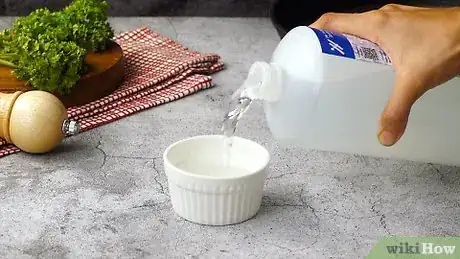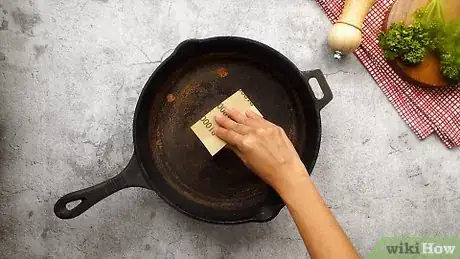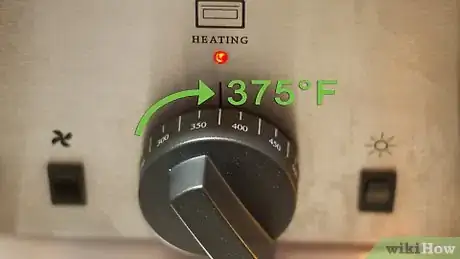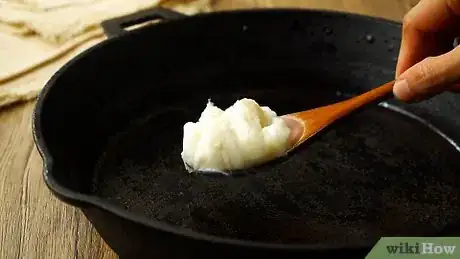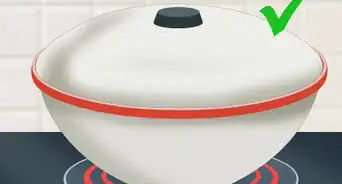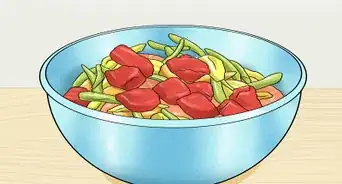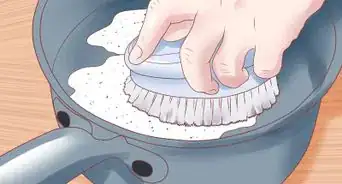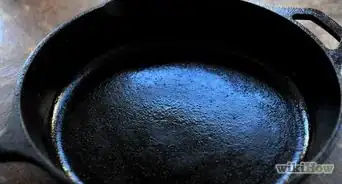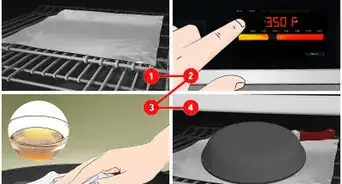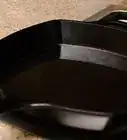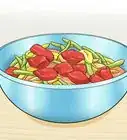This article was co-authored by Kadi Dulude. Kadi Dulude is a House Cleaning Professional and the Owner of Wizard of Homes, a New York City-based cleaning company. Kadi has over 10 years of experience and manages a team of over 90 registered cleaning professionals. Her cleaning advice has been featured in Architectural Digest and New York Magazine.
wikiHow marks an article as reader-approved once it receives enough positive feedback. This article received 19 testimonials and 100% of readers who voted found it helpful, earning it our reader-approved status.
This article has been viewed 923,882 times.
Cast iron cookware is rightly praised for its durability, its natural non-stick qualities, and its ability to retain heat. However, cast iron does have a few disadvantages as well. Unlike modern teflon-coated aluminum cookware, cast iron can rust if it's exposed to water. Luckily, removing this rust usually isn't extremely difficult. With a mild abrasive and a little elbow grease, it's not hard to de-rust most cast iron pans and prepare them for a protective re-seasoning.
Steps
Cleaning a Rusty Skillet
-
1Scrub the rust with an abrasive pad. If you have either, a fine piece of steel wool or a copper pad work well for removing rust.[1] However, you can also get good results from non-metal abrasive products (e.g. Brillo, SOS, etc.). If the rust is stubborn, add a little water and some mild dish-washing soap as you scrub.
- Normally, it's a bad idea to try to clean a cast iron pan the same way you'd clean other metal cookware, since this can remove the protective layer of seasoning. However, if your pan has rust, this has already occurred, so it's best to clean the rust from the pan and re-season later.
-
2For mild rust, try scrubbing with baking soda. If the rust appears to be thin and light, you can often get away with using mild abrasives you probably already have in your kitchen. For example, to use baking soda as an abrasive, sprinkle a small amount onto the surface of the pan along with some water. Stir the baking soda with the water to make a rough paste, then use a rag to scrub the paste into the rusty spots of the pan.
- Once you've scrubbed the rusty areas, let the paste sit for a few minutes, then rinse it off with tap water. If any rust remains, repeat as needed or switch to a different abrasive.
Advertisement -
3Make a salt scrub. Another easy DIY abrasive uses salt and water. This method works almost exactly like the baking soda one above: make a rough paste of salt and water in the pan, then scrub it into the rusty spots with a rag.
- Because the salt crystals are a little larger and rougher than particles of baking soda, the paste will be slightly more abrasive. However, salt is still considered fairly gentle.
-
4For bad rust, use a heavy-duty cleaner. In some cases, simple abrasives won't remove rust on their own. In these cases, harsher chemical cleaners can help. For example, lower-priced toilet bowl cleaners containing roughly 20% hydrochloric acid (HCl) tend to well. HCl completely dissolves rust into a wet powder. In this state, it can easily be removed — consult the product's packaging for disposal instructions.
- HCl is a strong acid, so working with it requires great care to prevent chemical burns. Protect your skin, hands, and eyes — wear gloves, a long-sleeved shirt, and safety goggles or other eye protection (which can usually be purchased for fairly cheap at universities with chemistry departments). Always use good ventilation and avoid breathing the product's fumes. Strong acids can irritate the throat and lungs, especially in people with asthmatic or lung conditions.
- Beware: HCl will dull coated or plated screws and polished, shiny iron or steel, and such.
-
5Rinse the pan and dry thoroughly. After cleaning, give the pan a thorough rinsing to remove any loosened rust or cleaning products. If you used HCl, consult the product's packaging for disposal instructions instead. When the pan is clean, dry with a clean rag or paper towel. Be sure to get all the water out — missing even a little can cause rust to re-form.
- After drying with a towel, try heating the pan on the stove over medium heat for about five minutes. This will remove any last traces of water, leaving you with a completely dry pan. Use care when handling the hot pan.
- After removing rust, it is highly recommended that you season your pan. This is an easy process that essentially gives the cast iron a protective layer of fat which prevents future rusting and also keeps food from sticking as it cooks. See the section below for information on seasoning your pan.
-
6For pans with severe rust, use professional-quality abrasion.
Re-seasoning the Pan
-
1Preheat your oven to 350 F (177 C). The seasoning process requires you to basically "bake" a layer of fat into the pan so that it stays there semi-permanently. The fat protects the iron surface from oxidation (rusting).[2] To start, warm up your oven. You can proceed to the next few steps while you wait.
-
2Coat the dry pan with cooking oil. Generally, the easiest source of fat to work with for this purpose is cooling oil (e.g., canola oil, vegetable oil, peanut oil, etc.). Pour a small amount (no more than about one tablespoon) into the skillet and spread it around with a paper towel, coating the entire surface. Many chefs like to coat the underside and handle as well, though this is less important.
- Olive oil isn't the best for this task — it has a lower smoke point than most other cooking oils, which means that it's more likely to give off smoke and may possibly set off your smoke alarm.[3]
-
3Alternatively, use another source of fat. You don't have to use oil — most types of cooking fat will work well. A few ideas are provided below:
- One easy solution is to use bacon grease. Cook the bacon in the cast iron pan, drain the excess grease into a pan, and use a paper towel to coat the pan evenly with the remainder.
- Lard or shortening also work well. For these fats, use a slightly lower temperature. 275-300 F (135-149 C) usually works well.[4]
-
4Put the skillet into the oven for an hour. Place the pan directly on a rack in the middle of the oven upside down (so the cooking surface faces the bottom of the oven. Put a baking sheet underneath to catch drips of excess oil. Let the pan "bake" like this for about one hour.
-
5Turn off the oven. After an hour, turn off the oven but don't open it. Let it gradually cool — this may take an extra hour or two. When the pan is cool enough to handle safely (use an oven mitt if you are unsure), take it out of the oven. Congratulations — it's now seasoned. It should resist rusting and stick to food less in the future.
- If you wish, you can partially re-season your pan whenever you wish by adding a little extra fat after the next few times you cook. Just apply oil, lard, etc. with a paper towel as above, covering the surface evenly with a thin layer. This isn't essential, but it's a wise idea if you accidentally take some of the seasoning off (see below).
Expert Q&A
-
QuestionHow do you get rid of rust on a cast iron pan?
 Kadi DuludeKadi Dulude is a House Cleaning Professional and the Owner of Wizard of Homes, a New York City-based cleaning company. Kadi has over 10 years of experience and manages a team of over 90 registered cleaning professionals. Her cleaning advice has been featured in Architectural Digest and New York Magazine.
Kadi DuludeKadi Dulude is a House Cleaning Professional and the Owner of Wizard of Homes, a New York City-based cleaning company. Kadi has over 10 years of experience and manages a team of over 90 registered cleaning professionals. Her cleaning advice has been featured in Architectural Digest and New York Magazine.
House Cleaning Professional Use a metal scouring pad, water and soap to scrub off the rust. Wash it off. Dry the pan and rub flaxseed or olive oil on it, then place it in the oven at around 450-500 for at least an hour. Let it cool off, repeat the oil+oven process if needed.
Use a metal scouring pad, water and soap to scrub off the rust. Wash it off. Dry the pan and rub flaxseed or olive oil on it, then place it in the oven at around 450-500 for at least an hour. Let it cool off, repeat the oil+oven process if needed. -
QuestionI bought a very rusty and pitted cast iron dutch oven. How do I know if it is beyond help? How do I restore it?
 Community AnswerCast iron is really never beyond help. I found one buried from a flood for many years, and took it to a company that did sand blasting. Poof, no more rust or pits! Took it home and seasoned it, and I've been using it for years since.
Community AnswerCast iron is really never beyond help. I found one buried from a flood for many years, and took it to a company that did sand blasting. Poof, no more rust or pits! Took it home and seasoned it, and I've been using it for years since. -
QuestionI bought a used Lodge cast iron skillet but some of the finish inside is dull and it seems to have a thin layer of the surface missing or chipped off where dull areas show through. What can I do to fix it?
 Community AnswerThe thin layer is probably just previous seasoning. The easiest way to remove it is to put it in a self-cleaning oven and run the cycle. Be sure to season it again after it's been cleaned.
Community AnswerThe thin layer is probably just previous seasoning. The easiest way to remove it is to put it in a self-cleaning oven and run the cycle. Be sure to season it again after it's been cleaned.
References
- ↑ http://www.thekitchn.com/how-to-restore-a-rusty-cast-iron-skillet-cleaning-lessons-from-the-kitchn-203086
- ↑ http://www.thekitchn.com/how-to-restore-a-rusty-cast-iron-skillet-cleaning-lessons-from-the-kitchn-203086
- ↑ http://www.seriouseats.com/2014/05/cooking-fats-101-whats-a-smoke-point-and-why-does-it-matter.html
- ↑ http://lifehacker.com/5886819/rescue-your-cast-iron-from-rust-with-vinegar
About This Article
To remove rust from a cast iron skillet, start by sprinkling a small amount of baking soda and water on the pan. Then, use a rag to scour away the rusty spots. You can also use a paste of salt and water to scrub away the rust. For pans with severe rust, try using a cleaning product with 20% hydrochloric acid, such as a low-priced toilet bowl cleaner. Once the rust is gone, rinse and thoroughly dry the pan with a paper towel. For tips on re-seasoning your pan once you’ve removed the rust, read on!

